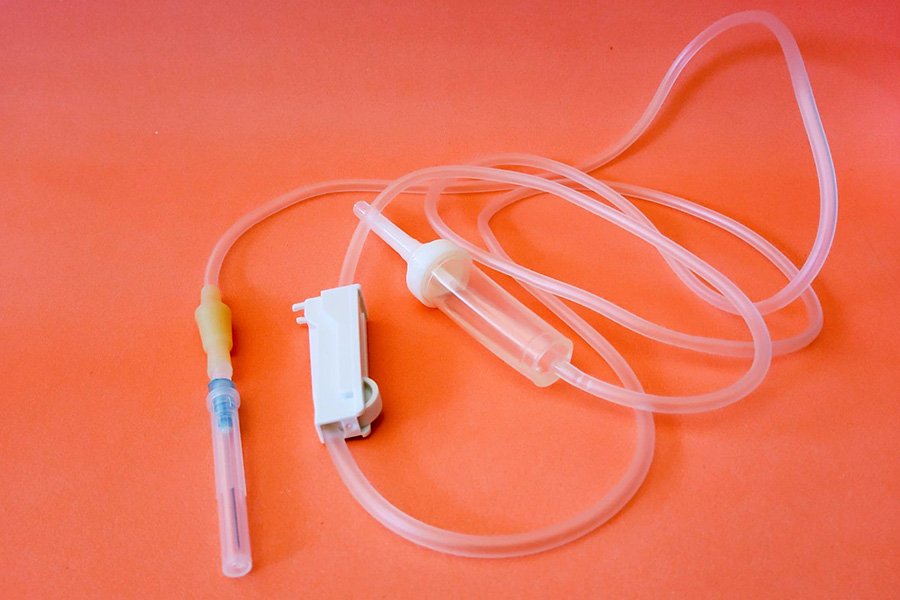Knowledge of IV therapy is essential, especially for patients who have been recommended this type of therapy. Although most patients understand what IV therapy is, very few are familiar with the different types of IV tubing.
So, what is IV tubing, and where is it most often used? Read on as the most important types of IV tubing will be listed and in what cases they are indicated.

Source: shutterstock.com/ Photo Contributor: Nyong DNZ
Types of IV Tubing
IV therapy is one of the fastest ways to get the necessary minerals, vitamins, and medications the body needs. Unlike oral intake, IV therapy bypasses the digestive system and allows the nutrients to be delivered directly into the patient’s bloodstream.
For this purpose, medical professionals use IV sets to perform the task safely. Such sets are designed to ensure a reduced risk of infections and to optimize infusion delivery.
Namely, these sets consist of a bag filled with IV fluid, a tube that is connected to the bag through which the fluid passes, and a needle that injects the IV contents directly into the bloodstream.
In addition, different types of IV sets are used in different situations and patients with different health conditions. Let’s take a look at the types of IV tubes used for mobile IV drip AZ below:
Filtered IV tubing
The filtered IV tubing set consists of a micron solution filter that is usually located in the drip chamber. Such a filter can help filter out any potential contaminants that may be found in the IV fluid.
Such pollutants can be bacteria, harmful particles, air embolisms, etc. If care is not taken when using this set, it can cause phlebitis or inflammation of the blood vessels. In addition, before administering IV fluids, clinicians pay attention to drug particle size and filter sizes.
If an appropriate filter is chosen, the drug will pass smoothly through the filter into the bloodstream. On the other hand, if a drug-impermeable filter is chosen, the drug molecules will bind to the filter and be unnecessarily removed from the IV fluid.
Vented IV tubing
Such sets contain glass or plastic IV containers. The fluid from the IV fluids will not be able to drain unless you drain it.
Namely, these IV sets have an air vent above the chamber that can be opened or closed. This allows air to enter the chamber and displace the IV fluid as it is infused. To enable this flow of IV fluids, two forces act– the air pressure produced by air entering the chamber and the force of gravity.
Gravitational force pulls the IV fluid down, while air pressure pushes the fluid down. Also, the force of gravity increases when the bag is raised from the IV setup, thus increasing the flow of IV fluid. On the other hand, if the IV bag is lowered lower, the fluid flow will decrease.
Non-Vented tubing
As the name suggests, non-vented tubing uses kits that do not have air vents in the tubing. Such sets are ideal for collapsible plastic bags because this tubing creates a vacuum that makes the IV bag shrink while the liquid drains.
In such sets, two forces act– the gravitational force and the force coming from the collapsing fluid container.
Gravity tubing
This type of tubing is among the most popular and used throughout history. Namely, gravity tubing uses two factors, the flow rate of IV fluids and gravity regulators, to deliver the necessary nutrients or drugs.
In gravity tubing, an IV bag filled with IV fluid is placed on a pole above the patient. With the help of gravity, the IV fluid passes through the tubing and enters the patient’s bloodstream.
This type of tubing also depends on fluid flow rate regulators. Therefore, gravity infusion rates can be set in drops per minute corresponding to milliliters per infusion rate.

Source: shutterstock.com/ Photo Contributor: MedstockPhotos
How to choose the right IV tubing
The choice of IV tubing is made by medically licensed persons. Therefore, the type of IV tubing depends mostly on the type of IV therapy to be received and mostly on the patient’s health condition.
Patients should never be encouraged to self-administer IV therapy. Instead, they should contact a medical professional to help them choose the appropriate therapy for their needs and perform the entire procedure.
Self-administration of the therapy without a proper medical license can lead to more side effects, such as swelling, redness, bleeding at the injection site, or infection.
Conclusion
Knowing the types of IV tubing and how to use it is important for successful IV therapy. Therefore, proper administration and use can allow the patient to obtain the necessary nutrients quickly.
So, if you need IV therapy, it is best to consult your doctor, who will assess whether your health condition requires such therapy.




